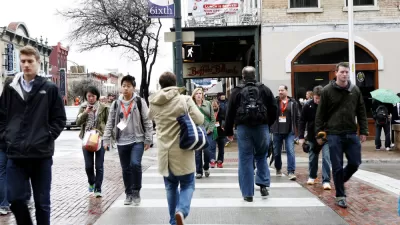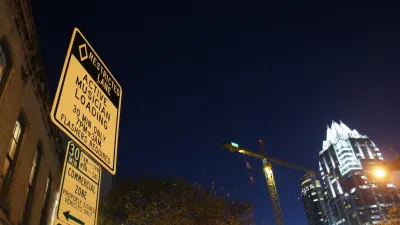The "missing middle" of housing is a concept familiar to many planners, but it's still probably unknown to most of the public. A story for Austin's NPR station could be an indication that the missing middle is entering the public consciousness.

Audrey McGlinchy kicks off the first of a two-part series about missing-middle housing and CodeNEXT—the city of Austin's ongoing zoning code update—with the story of Annette Naish, who lives in a two-bedroom, one-and-a-half-bath bought for $57,000 in the late 1990s. "Naish lives in a fourplex, or one unit in a group of four attached homes. It’s a rare breed in Austin. Some say it’s missing," writes McGlinchy.
"The term 'missing-middle' housing was coined by the head of Opticos Design Inc., the consultant helping the City of Austin with CodeNEXT, the rewrite of the land development code," adds McGlinchy, to begin the explainer of a concept usually in the purview of APA conferences and Planetizen posts.
The public is more and more aware of the issues of housing affordability around the country, so it makes sense that more and more of the public should be aware of the missing middle concept.
Researchers at the University of Southern California Price School of Public Policy recently found that the construction of missing-middle housing peaked in the 1970s and '80s. (Naish’s fourplex, for example, was built in 1972.) But since 1990, the construction of missing-middle housing has made up only about 15 percent of new housing stock in the U.S.
The article includes more on the case for missing middle housing, especially the benefits of affordability relative to the other types of housing available in Austin, and cities around the country. It should also not come as a surprise that missing middle housing is one of the goals of the code regulations proposed by the draft versions of CodeNEXT, released in February.
FULL STORY: What Is 'Missing-Middle' Housing?

Planetizen Federal Action Tracker
A weekly monitor of how Trump’s orders and actions are impacting planners and planning in America.

Congressman Proposes Bill to Rename DC Metro “Trump Train”
The Make Autorail Great Again Act would withhold federal funding to the system until the Washington Metropolitan Area Transit Authority (WMATA), rebrands as the Washington Metropolitan Authority for Greater Access (WMAGA).

DARTSpace Platform Streamlines Dallas TOD Application Process
The Dallas transit agency hopes a shorter permitting timeline will boost transit-oriented development around rail stations.

Texas Moves to Curb Orphan Wells, But Critics Say Loopholes Remain
A proposed state law would shift financial responsibility for sealing unused drilling sites from the public to energy operators, though some advocates question its effectiveness due to industry-backed exemptions.

Affordable Housing Finance 101
The financial intricacies involved in building affordable housing can be difficult to understand. This explainer breaks down the foundational concepts.

San Francisco's School District Spent $105M To Build Affordable Housing for Teachers — And That's Just the Beginning
SFUSD joins a growing list of school districts using their land holdings to address housing affordability challenges faced by their own employees.
Urban Design for Planners 1: Software Tools
This six-course series explores essential urban design concepts using open source software and equips planners with the tools they need to participate fully in the urban design process.
Planning for Universal Design
Learn the tools for implementing Universal Design in planning regulations.
Municipality of Princeton
Roanoke Valley-Alleghany Regional Commission
City of Mt Shasta
City of Camden Redevelopment Agency
City of Astoria
Transportation Research & Education Center (TREC) at Portland State University
US High Speed Rail Association
City of Camden Redevelopment Agency
Municipality of Princeton (NJ)





























